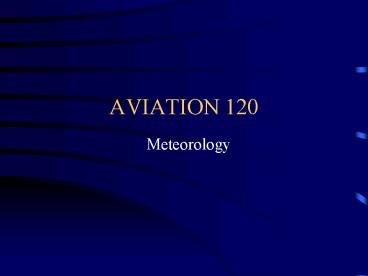AVIATION 120 - PowerPoint PPT Presentation
1 / 14
Title: AVIATION 120
1
AVIATION 120
- Meteorology
2
Todays Agenda
- Causes of instability
- Modifications
- Cloud development
3
Causes of Instability
- Increasing the steepness of the environmental
lapse rate will increase the instability of the
air - Any process that will cool the air aloft and/or
heat the air at the surface will steepen the ELR - Such processes include
- Cooling aloft
- Warming at the surface
- Mixing
- Lifting
4
Causes of Instability (cont.)
- Cooling aloft can be caused by
- Cold air advection aloft
- Radiational cooling
- Warming at the surface can be caused by
- Air moving over a warm surface (Advective
warming) - Warm air advection
- Daytime heating of the surface
- Localized warming such as fires and industrial
activity can cause instability
5
Causes of Instability (cont.)
- Mixing can be caused by
- Wind induced turbulent eddies (mechanical
turbulence) - Convection
6
Causes of Instability (cont.)
- Lifting
- Due to the fact that lifted air stretches out,
the top of a lifted layer will cool more than the
bottom - Saturated lower level in a lifted layer can also
enhance instability of a lifted layer - Air may be lifted due to frontal lift, terrain,
convergence at the surface and/or divergence aloft
7
Modification of Stability
- Not only can instability be caused by surface
warming, cooling aloft, mixing or lifting, but
stability can be modified by these same processes - Stability will be increased with warming aloft,
surface cooling, descending air and reduced
mixing
8
Cloud Development
- Most clouds develop from one of the following
- Surface heating and free convection
- Widespread ascent due to convergence of surface
air - Frontal lift
- Topography
9
Categories of Cloud
- Layer type clouds form in stable air
- Fog, Stratus, Nimbostratus, Altostratus,
Cirrostratus, cirrus, etc. - Stable air moving over mountains can cause
mountain wave type cloud - Altocumulus Standing Lenticular (ACSL), banner
clouds, rotor clouds - Vertically developed clouds form in unstable air
- Cumulus, Altocumulus, Altocumulus Castellanus,
Towering Cumulus, Cumulonimbus etc.
10
Cloud Development in Unstable Air
- Convection or forced lifting will cause air to
rise and as a result, cool - Initially, if the air is unsaturated, it will
cool 10C for each 1000m (DALR) it rises - If/When the air saturates, it will continue to
cool, but a a much slower rate which averages 6C
(SALR) for each 1000m it rises - If the air saturates, this is the level of the
base of any vertically developed cloud - If the air is conditionally unstable, saturation
will cause the air to become unstable and the air
will continue to rise buoyantly - Convective cloud bases can be estimated using the
formula H(ft)228(T-Td) See Focus, pg 155,
Meteorology Today
11
Development of a Cumulus Cloud
12
Types of Vertical Clouds
13
Cloud Development due to Topography
14
UACN01 CYEG 102227 EG UUA /OV CYXY 270130 2227
FL 330 /TP B747 /RM BRF 1 TO 2 MIN OF SVR WAVE
TURBC.... EGACC/FIC































